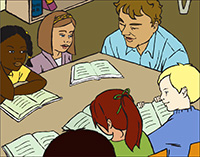How can Mr. Brewster and the other school professionals at Rosa Parks Elementary School prepare to implement RTI?
Page 3: Once School Starts
 Having organized his classroom and planned for the school year, Mr. Brewster now feels that implementing RTI will be quite manageable and will actually be easy to work into his normal classroom routine. However, though Mr. Brewster begins providing high-quality instruction immediately, he realizes that there are a number of things he should do before the universal screenings are completed. Now that the students have arrived, Mr. Brewster decides to:
Having organized his classroom and planned for the school year, Mr. Brewster now feels that implementing RTI will be quite manageable and will actually be easy to work into his normal classroom routine. However, though Mr. Brewster begins providing high-quality instruction immediately, he realizes that there are a number of things he should do before the universal screenings are completed. Now that the students have arrived, Mr. Brewster decides to:
- Use last year’s assessment data to make instructional grouping decisions
- Prepare his students
 In most schools, there will be a period of at least one to two weeks before universal screening data collection is completed and Tier 1 progress monitoring begins. During that time, the teacher should deliver high-quality instruction in a variety of settings (e.g., whole-group instruction, small-group instruction). For small-group instruction, the teacher will need to create groups based on student characteristics, such as ability level. He or she can do so by using last year’s data to form small groups (e.g., several students received Tier 2 intervention in first grade and may benefit from the same small-group instruction). When the universal screening data have been collected, the teacher can use the information to restructure small groups and to plan paired instruction. Grouping practices and students’ assignment to particular groups should be adjusted periodically in response to student data.
In most schools, there will be a period of at least one to two weeks before universal screening data collection is completed and Tier 1 progress monitoring begins. During that time, the teacher should deliver high-quality instruction in a variety of settings (e.g., whole-group instruction, small-group instruction). For small-group instruction, the teacher will need to create groups based on student characteristics, such as ability level. He or she can do so by using last year’s data to form small groups (e.g., several students received Tier 2 intervention in first grade and may benefit from the same small-group instruction). When the universal screening data have been collected, the teacher can use the information to restructure small groups and to plan paired instruction. Grouping practices and students’ assignment to particular groups should be adjusted periodically in response to student data.
Activity
 Mr. Brewster has gathered last year’s data for nearly all of his students from Rosa Parks’s first-grade teachers. For those students transferring from other schools, he has gathered the information from their cumulative files. Help Mr. Brewster create initial groupings based on last year’s results.
Mr. Brewster has gathered last year’s data for nearly all of his students from Rosa Parks’s first-grade teachers. For those students transferring from other schools, he has gathered the information from their cumulative files. Help Mr. Brewster create initial groupings based on last year’s results.
Although Mr. Brewster has spent a couple of weeks preparing for the school year, he realizes that the students would also benefit from a little preparation. He decides to devote time during the first two weeks of school helping his students to understand his expectations and to acquire the preliminary skills they’ll need if effective classroom instruction is to occur. Mr. Brewster compiles a list of items to address:
-
- Explain the classroom management system
– Make sure to include expectations, rules, and consequences - Discuss transitioning from different types of reading instruction (whole-group,
pairs, centers)
– Model appropriate behavior - Train the students on how to work in small groups, pairs, and centers
– Play instructional board games to get kids accustomed to interacting with
each other in a positive way - Discuss procedures for getting and turning in materials
– Center materials (colored folders at different levels are located next to
each center station)
– Progress monitoring graphs (individual folders, bookcase in-box) - Model partner-reading elements
– Respect your partner
– Provide immediate corrective feedback - Teach students to graph their own progress monitoring data
– Allow students to decorate their graphs
- Explain the classroom management system
For Your Information
Students who are aware of their progress are more knowledgeable about their learning. When they see their academic growth in an easily understood format— such as on a graph—students begin to recognize the relationship between their efforts and progress. In fact, using graphs in this way has a number of benefits, in that graphs:
-
-
- Offer students a visual representation of their progress
- Provide students with specific feedback that their hard work is paying off
- Motivate students to maintain their efforts or to work harder
-